2020中考初中英语-介词专题讲解
- 格式:docx
- 大小:38.69 KB
- 文档页数:15
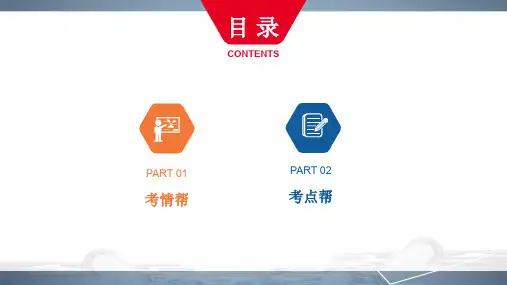
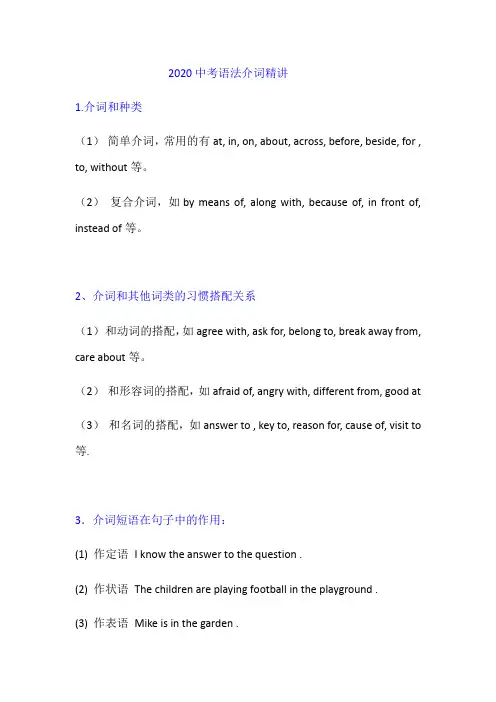
2020中考语法介词精讲1.介词和种类(1)简单介词,常用的有at, in, on, about, across, before, beside, for , to, without等。
(2)复合介词,如by means of, along with, because of, in front of, instead of等。
2、介词和其他词类的习惯搭配关系(1)和动词的搭配,如agree with, ask for, belong to, break away from, care about等。
(2)和形容词的搭配,如afraid of, angry with, different from, good at (3)和名词的搭配,如answer to , key to, reason for, cause of, visit to 等.3.介词短语在句子中的作用:(1) 作定语I know the answer to the question .(2) 作状语The children are playing football in the playground .(3) 作表语Mike is in the garden .(4) 作宾补语He found himself in the middle of the mountain .(5) 作主补语Tom was seen inside the classroom .4、常考介词的意义与用法区别(1)表示时间的介词A. in; on; atB. in; after; laterC. for; sinceD. after; behind(2)表示方位的介词A. over; above;onB. in; atC. in; on; toD. among; betweenE. across;through; pastF. in the wall; on the wall; in the tree;on the treeG. in front of; in the front ofH. except; besides; butI.by; with; in。
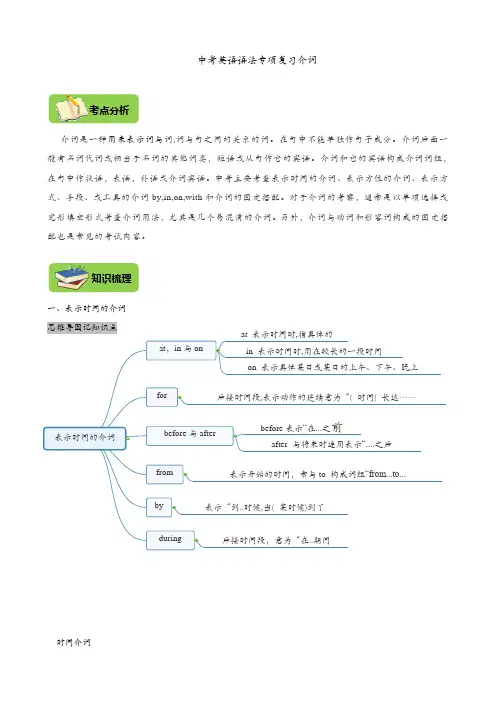
中考英语语法专项复习介词介词是一种用来表示词与词,词与句之间的关系的词。
在句中不能单独作句子成分。
介词后面一般有名词代词或相当于名词的其他词类,短语或从句作它的宾语。
介词和它的宾语构成介词词组,在句中作状语,表语,补语或介词宾语。
中考主要考查表示时间的介词、表示方位的介词、表示方式、手段、或工具的介词by,in,on,with 和介词的固定搭配。
对于介词的考察,通常是以单项选择或完形填空形式考查介词用法,尤其是几个易混淆的介词。
另外,介词与动词和形容词构成的固定搭配也是常见的考试内容。
一、表示时间的介词 思维导图记知识点时间介词考点分析知识梳理 表示时间的介词at ,in 与onforbefore 与afterfrombyduring in 表示时间时,用在较长的一段时间on 表示具体某日或某日的上午、下午、晚上后接时间段,表示动作的延续意为“( 时间) 长达……before 表示“在...之前after 与将来时连用表示“....之后表示开始的时间,常与to 构成词组“from...to...表示“到..时候,当( 某时候)到了后接时间段,意为“在..期间二、表示方位的介词 思维导图记知识点介词on 表示一物放在另一物上面, 两者紧贴在一起三、表示方式、手段、或工具的介词by,in,on,with.用by 时,交通工具前不用任何词四.常用介词辨析两个词都有“在...后”之意,behind 只表示位置方面的“在....之后”,不能表示时间,而after则表示时间方面的“在...之后”behind the school 在学校后面after 5 o’clock 5点以后(1)of sb 用于It is +adj+of sb to do sth 句型中,形容词为clever, kind , nice 等描述人物性格特征的词,of 后的人物与形容词有主表关系。
It is very kind of you to help the old man .你帮助那位老人真是太好了。
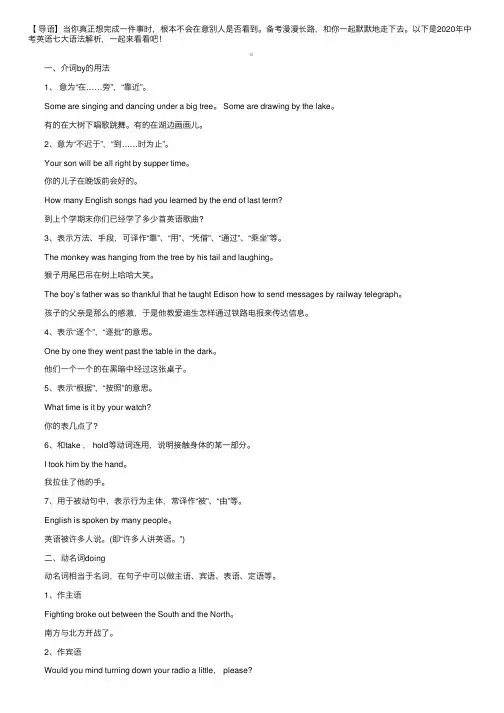
【导语】当你真正想完成⼀件事时,根本不会在意别⼈是否看到。
备考漫漫长路,和你⼀起默默地⾛下去。
以下是2020年中考英语七⼤语法解析,⼀起来看看吧! ⼀、介词by的⽤法 1、意为“在……旁”,“靠近”。
Some are singing and dancing under a big tree。
Some are drawing by the lake。
有的在⼤树下唱歌跳舞。
有的在湖边画画⼉。
2、意为“不迟于”,“到……时为⽌”。
Your son will be all right by supper time。
你的⼉⼦在晚饭前会好的。
How many English songs had you learned by the end of last term? 到上个学期末你们已经学了多少⾸英语歌曲? 3、表⽰⽅法、⼿段,可译作“靠”、“⽤”、“凭借”、“通过”、“乘坐”等。
The monkey was hanging from the tree by his tail and laughing。
猴⼦⽤尾巴吊在树上哈哈⼤笑。
The boy’s father was so thankful that he taught Edison how to send messages by railway telegraph。
孩⼦的⽗亲是那么的感激,于是他教爱迪⽣怎样通过铁路电报来传达信息。
4、表⽰“逐个”,“逐批”的意思。
One by one they went past the table in the dark。
他们⼀个⼀个的在⿊暗中经过这张桌⼦。
5、表⽰“根据”,“按照”的意思。
What time is it by your watch? 你的表⼏点了? 6、和take , hold等动词连⽤,说明接触⾝体的某⼀部分。
I took him by the hand。
我拉住了他的⼿。
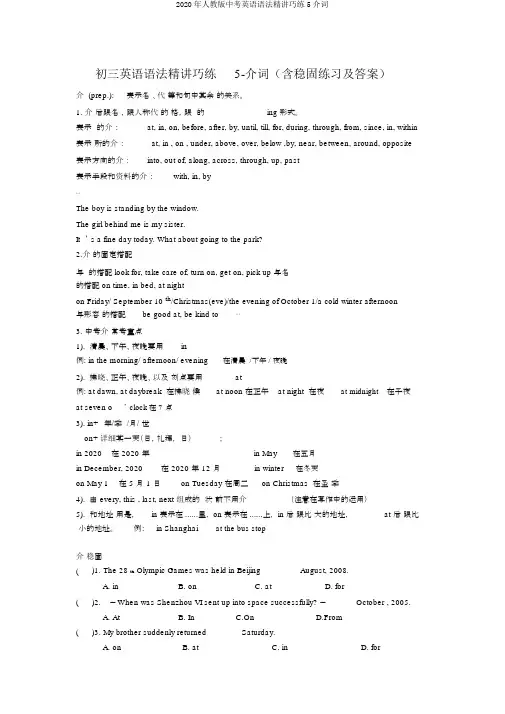
初三英语语法精讲巧练5-介词(含稳固练习及答案)介 (prep.):表示名、代等和句中其余的关系。
1. 介后跟名,跟人称代的格,跟的ing 形式。
表示的介:at, in, on, before, after, by, until, till, for, during, through, from, since, in, within 表示所的介:at, in , on , under, above, over, below ,by, near, between, around, opposite 表示方向的介:into, out of, along, across, through, up, past表示手段和资料的介:with, in, by⋯The boy is standing by the window.The girl behind me is my sister.It ’ s a fine day today. What about going to the park?2.介的固定搭配与的搭配 look for, take care of, turn on, get on, pick up 与名的搭配 on time, in bed, at nighton Friday/ September 10 th/Christmas(eve)/the evening of October 1/a cold winter afternoon与形容的搭配be good at, be kind to⋯3. 中考介常考重点1). 清晨、下午、夜晚要用in例: in the morning/ afternoon/ evening 2). 拂晓、正午、夜晚、以及刻点要用在清晨at/下午 / 夜晚例: at dawn, at daybreak 在拂晓候at noon 在正午at night 在夜at midnight at seven o’ clock在7点3). in+年/季/月/世on+ 详细某一天(日,礼拜,日);in 2020在2020年in May在五月in December, 2020在2020年12月in winter在冬天on May 1在5月1日on Tuesday 在周二on Christmas 在圣季4). 由 every, this , last, next 组成的状前不用介(注意在写作中的运用)5). 和地址用是,in 表示在 ......里, on 表示在 ......上, in 后跟比大的地址,小的地址。
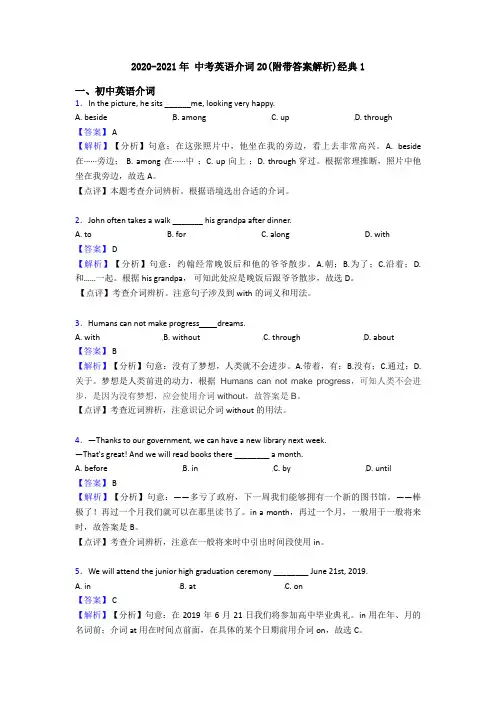
2020-2021年中考英语介词20(附带答案解析)经典1一、初中英语介词1.In the picture, he sits ______me, looking very happy.A. besideB. amongC. upD. through【答案】 A【解析】【分析】句意:在这张照片中,他坐在我的旁边,看上去非常高兴。
A. beside 在······旁边; B. among 在······中;C. up 向上;D. through穿过。
根据常理推断,照片中他坐在我旁边,故选A。
【点评】本题考查介词辨析。
根据语境选出合适的介词。
2.John often takes a walk _______ his grandpa after dinner.A. toB. forC. alongD. with【答案】 D【解析】【分析】句意:约翰经常晚饭后和他的爷爷散步。
A.朝;B.为了;C.沿着;D.和……一起。
根据his grandpa,可知此处应是晚饭后跟爷爷散步,故选D。
【点评】考查介词辨析。
注意句子涉及到with的词义和用法。
3.Humans can not make progress dreams.A. withB. withoutC. throughD. about【答案】 B【解析】【分析】句意:没有了梦想,人类就不会进步。
A.带着,有;B.没有;C.通过;D.关于。
梦想是人类前进的动力,根据Humans can not make progress,可知人类不会进步,是因为没有梦想,应会使用介词without,故答案是B。
【点评】考查近词辨析,注意识记介词without的用法。
4.—Thanks to our government, we can have a new library next week.—That's great! And we will read books there ________ a month.A. beforeB. inC. byD. until【答案】 B【解析】【分析】句意:——多亏了政府,下一周我们能够拥有一个新的图书馆。

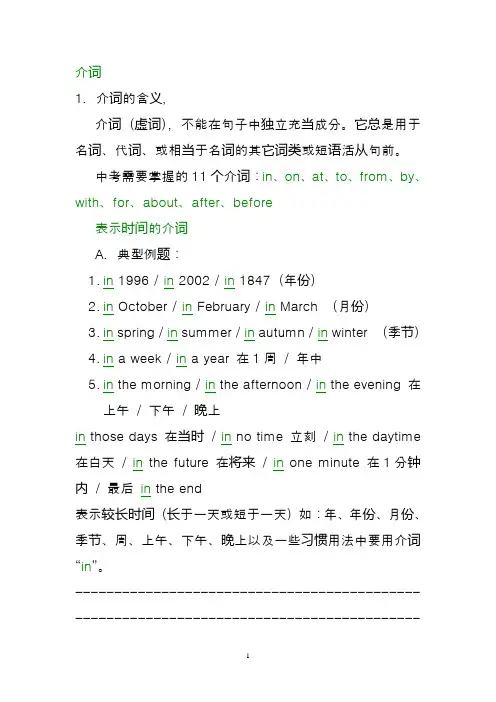
介词1.介词的含义,介词(虚词),不能在句子中独立充当成分。
它总是用于名词、代词、或相当于名词的其它词类或短语活从句前。
中考需要掌握的11个介词:in、on、at、to、from、by、with、for、about、after、before表示时间的介词A.典型例题:1.in 1996 / in 2002 / in 1847(年份)2.in October / in February / in March (月份)3.in spring / in summer / in autumn / in winter (季节)4.in a week / in a year 在1周/ 年中5.in the morning / in the afternoon / in the evening 在上午/ 下午/ 晚上in those days 在当时/ in no time 立刻/ in the daytime 在白天/ in the future 在将来/ in one minute 在1分钟内/ 最后in the end表示较长时间(长于一天或短于一天)如:年、年份、月份、季节、周、上午、下午、晚上以及一些习惯用法中要用介词“in”。
-------------------------------------------------------------------------------------------------------------------------------- B.典型例题:1.at ten o’clock / at seven thirty. (表示某一钟点)2.at noon / at night / at midnight (在中午、晚上、半夜――一天中相对短暂的时间)3.at the age of twenty / at the age of thirty-five (表示某一年龄)4.at that time 在那时/ at the moment 这时、那时、此刻/ at first 首先/ at last 最后=in the end / at once 立刻、马上/ at / on (the) weekends 在周末/ 在一年中的这个时候at this time of year / 在……开始/结束时at the beginning /end of表示时间的某一点(或表示某时刻)如:钟点、年龄或其它的习惯用法中要用“at”。
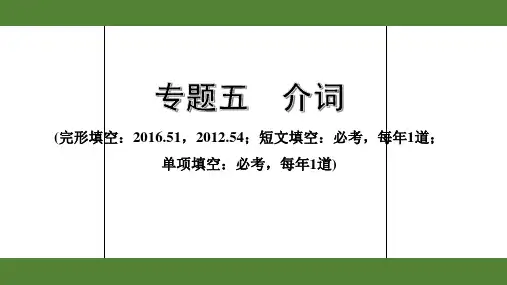
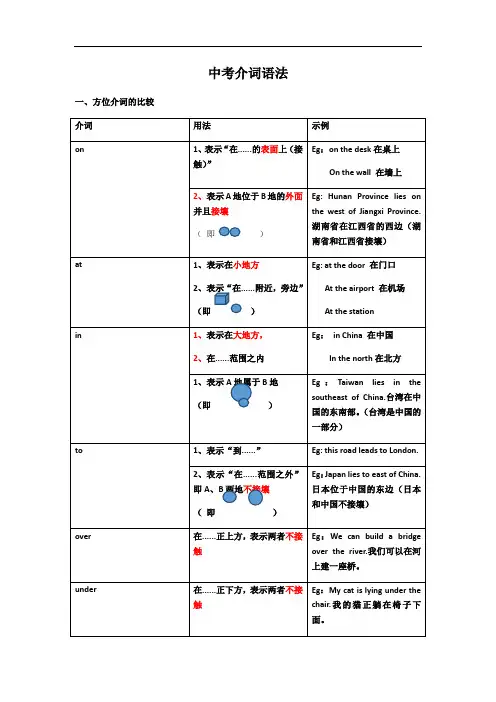
中考介词语法一、方位介词的比较二、方式介词的比较(注意:by car=on a bike=ride a bike; by car=in a car=drive a car)三、时间介词的比较四、其他常见的介词比较一、英语阅读理解专项练习试卷1.阅读理解Happiness is important for everyone. Most people want to be happy, but few know how to find happiness. Here is a story to help you.Once a bird lived unhappily. So it traveled far away to look for its happiness. It flew and flew. Suddenly it saw a spider climbing up a wall. The spider fell off the wall halfway. But it kept climbing again and fell off again. Even so, the spider didn't give up. The little bird asked the spider in surprise. "Why don't you have pain but happiness on your face though you fail again and again?""Because I keep making my efforts. I'm happy." said the spider.Then the little bird saw it happiness is a will in the heart.The bird continued flying and saw a lame duck help a little duck who got lost to find the way back home. Although it was disabled, it had a smiling face."I'm happy because I can help others." said the lame duck. So the bird saw it happiness is a love in the heart.The bird went on flying and suddenly saw a little dying flower, whose face was full of smile. The bird didn't know the reason. So it asked the little flower, "You're going to die. Why are you still so happy?" "Because my dream will come true," said the little flower." What is your dream?" "To produce sweet fruit." The little bird saw it: happiness is a hope in the heart.So the little bird no more looked for happiness because it had seen the truth happiness is not in the faraway place but in your own heart. You are the maker of your own happiness.(1)Who never gave up though it failed again and again in this passage?A. The bird.B. The spider.C. The flower.D. The duck.(2)Why is the little dying flower still so happy?A. Because it often helps others.B. Because it'll produce sour fruit.C. Because it has a hope in the heart.D. Because it keeps climbing up a wall.(3)What can we know from the story?A. The bird found happiness in its own heart.B. The bird found happiness in the faraway place.C. The bird didn't know where happiness was at last.D. The lame duck wasn't happy because it had to help others.(4)Which of the following is NOT true according to the passage?A. Happiness is important for everyone.B. Many people know how to find happiness.C. We make happiness by ourselves.D. The way to happiness is to have a dream, to help others and not to give up.(5)The passage is mainly about .A. willB. hopeC. loveD. happiness【答案】(1)B(2)C(3)A(4)B(5)D【解析】【分析】本文主要谈论了一个如何获得幸福的问题。
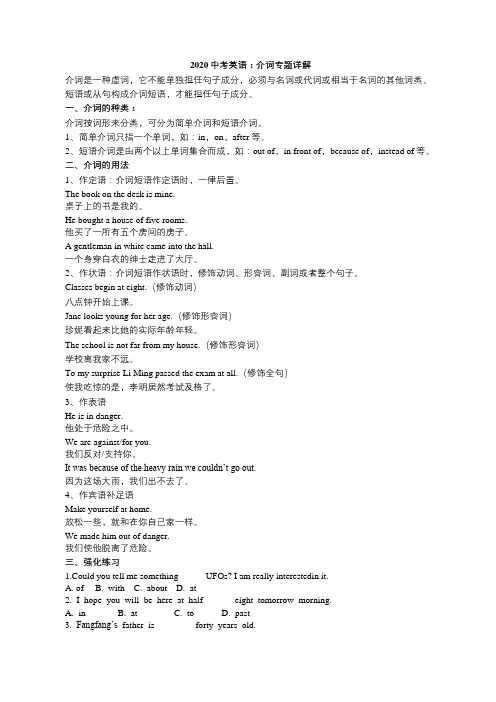
2020中考英语:介词专题详解介词是一种虚词,它不能单独担任句子成分,必须与名词或代词或相当于名词的其他词类、短语或从句构成介词短语,才能担任句子成分。
一、介词的种类:介词按词形来分类,可分为简单介词和短语介词。
1、简单介词只指一个单词,如:in,on,after等。
2、短语介词是由两个以上单词集合而成,如:out of,in front of,because of,instead of等。
二、介词的用法1、作定语:介词短语作定语时,一律后置。
The book on the desk is mine.桌子上的书是我的。
He bought a house of five rooms.他买了一所有五个房间的房子。
A gentleman in white came into the hall.一个身穿白衣的绅士走进了大厅。
2、作状语:介词短语作状语时,修饰动词、形容词、副词或者整个句子。
Classes begin at eight.(修饰动词)八点钟开始上课。
Jane looks young for her age.(修饰形容词)珍妮看起来比她的实际年龄年轻。
The school is not far from my house.(修饰形容词)学校离我家不远。
To my surprise Li Ming passed the exam at all.(修饰全句)使我吃惊的是,李明居然考试及格了。
3、作表语He is in danger.他处于危险之中。
We are against/for you.我们反对/支持你。
It was because of the heavy rain we couldn’t go out.因为这场大雨,我们出不去了。
4、作宾语补足语Make yourself at home.放松一些,就和在你自己家一样。
We made him out of danger.我们使他脱离了危险。
2020年中考英语介词语法知识辅导I介词的功能介词是一种虚词,用来表示名词或相当于名词的其它词语句中其它词的关系,不能单独使用。
介词可与名词或相当于名词的其它词构成介词短语。
介词短语可在句中作定语,状语,表语和宾语补足语。
例如:The boy over there is John’s brother. (定语)The girl will be back in two hours. (状语)Our English teacher is from Australia. (表语)Help yourself to some fish. (宾语补足语)II表示时间的介词表示“时间”的介词如下:1.表示年、月、日、时刻等用at,in,on2.表示时间的前后用 before, after3.表示期限等用by,until,till4.表示期间等用for,during,through5.表示时间的起点等用 from, since6.表示时间的经过等用in,within(1) at,on,in1)at:用于表示时刻、时间的某一点at noon正午时 at night在夜间 at present目前at nine(o’clock)在九点钟We usually have lunch at noon(at twelve).我们通常中午吃午饭(十二点吃午饭)。
(2)on:用于某天,某一天的上、下午(指具体的某一天时,一律用on)注意 :泛指一般的上午(下午)时用in,但特指某日的上午(下午)时用on。
in the morning在早上on sun day morning在周日早上on Monday在周一on Tuesday morning在周二早上on June 6在6月6日on May 4,1996在1996年5月4日on a cold night在一个寒冷的夜晚on the night of July(the) first在七月一日的夜晚We didn't listen to the lecture on Wednesday afternoon上周三下午我们没去听演讲。
2020年中考英语词法部分复习:介词1. 介词:表示它后面的名词或代词或相当于名词的其它词类、短语或从句,与其它句子成分的关系;介词不能单独使用,必须和它后面的名词、数词或相当于名词的词、短语或从句组成介词结构,一起作句子成分。
2. 介词的分类3. 意义相近的介词辨析1). in on at表示时间in在“段”内;on在“某天”和某一天的或有修饰语的上午、下午或晚上;at在“点”上。
以上情况可用下列口诀来记:(1). I was born in March. 我出生在三月份。
(2). I usually get up at six. 我通常6点起床。
(3). Come back on Friday. 星期五回来。
(4). Betty arrived in London on the evening of June 1st . 贝蒂在6月1日晚上抵达伦敦。
2). since , for表示时间Since +“时间点”,表示“从……时间以来”;for +“时间段”,表示“多长时间了”如:(1). Jack has studied Chinese in this school since the year of 2010.自从2010年以来,杰克就在这所学校学习汉语。
(2). –How long have you learned English ? –For about five years. 你学英语多长时间了?大约5年。
3). in , after表示时间in +“时间段”表示从现在算起的一段时间以后或表示某事发生在某段时间结束之前。
常用于将来时,提问用how soon ;after +“时间段”表示过去的一段时间以后,常用于过去时当中,提问用when , after +“时间点”,可用于将来时。
如:(1). Can you finish drawing a fine horse in five minutes ? 你能在5分钟内画出一匹骏马吗?(2). –How soon will you start ? – We’ll start in ten minutes.你们多久出发?我们10分钟后出发。
2020中考英语知识点讲解:介词和连词【考点直击】1. 常用介词及其词组的主要用法和意义;2. 常用动词、形容词与介词、副词的固定搭配及其意义。
3. 并列连词and, but, or, so等的主要用法;4. 常用的从属连词的基本用法【名师点睛】1. 介词的功能介词是一种虚词,用来表示名词或相当于名词的其它词语句中其它词的关系,不能单独使用。
介词可与名词或相当于名词的其它词构成介词短语。
介词短语可在句中作定语,状语,表语和宾语补足语。
例如:The boy over there is John’s brother. (定语)The girl will be back in two hours. (状语)Our English teacher is from Australia. (表语)Help yourself to some fish. (宾语补足语)2. 常用介词的用法辨析(1)表时间的介词1)at, in on表示时间点用at。
例如:at six o’clock, at noon,at midnight。
表示在某个世纪,某年,某月,某个季节以及早晨,上午,下午,晚上时,生活小常识,用in。
例如:in the ninettenth century, in 2002, in may, in winter, in the morning, in the afternoon等。
表示具体的某一天和某一天的上午,下午,晚上时,用on。
例如:on Monday, on July 1st, on Sunday morning 等。
2)since, after由since和after 引导的词组都可表示从过去某一点开始的时段,但since词组表示的时段一直延续到说话的时刻,因而往往要与现在完成时连用。
而after词组所表示的时段纯系过去,因而要与一般过去时连用。
例如:I haven’t heard from him since last summer.After five days the boy came back.3)in, afterin与将来时态连用时,表示“过多长时间以后”的意思,后面跟表示一段时间的词语。
中考初中英语-介词专题讲解一.概念:介词用来表明名词与句中其他词的关系,介词是虚词,不能独立充当句子成分介词短语能够充当句子成分, 介词短语= 介词+介词宾语(名词、宾格代词、动名词等充当)二、常用1、in 在......之内1) 表示地点,表示大地点。
She’s in China with her mom and dad.2)表示时间,表示在某一个时间段内The weather is cold in winter.3) 表示颜色和语言也用介词in。
Do you know the girl in red? I can write this article in English.2、from 从......中来1) come from I come from China and I’m Chinese.2) download from I download music from the Internet.3) be different from Lily’s habits are different from Linda’s.3. with 和,用,与1) with sb 和......人在一起I’m in Class One with Daming and Lingling. 2)with sth. 表示用某种工具I write with my pen, and I see with my eyes.4. at 在......1) 表地点,主小地点。
My father is a teacher at Beijing International School.2) 表时间,主指时间的一个点。
I get up at half past seven in the morning.3) be good at 擅长于...... I am good at reading and writing.5. behind 在......后面The classrooms are behind the offices.6. next to 紧挨着The library is next to the classrooms.7. in front of 在......前面They are in front of Tony and Daming.8. for 为了......,因为。
Thank you for your email.9. on 在......上,在......时1)表示时间,表示具体的一天。
Would you like to go to a football match on Sunday?2)表示地点on the farm on the playground10. to 自,向1)talk to 与......谈论We have a break and I talk to my friends.2) go to 去He likes films and he often goes to the cinema.3)welcome to 欢迎到...... Welcome to Beijing Zoo.4)listen to 听They always listen to music.5)connect......to .和...连接一起Please connect the monitor to the computer first.三、.常用的介词的区别:①in, to, on在方位名词前的区别1. in表示A地在B地范围之内,如Taiwan is in the southeast of China.2. to表示A地在B地范围之外(有距离),如:Japan lies to the east of China.3. on表示A地与B地接壤、毗邻,如:North Korea is on the east of China.②. at, in, on, by在表示时间上的区别1. at指时间表示:(1)时间的点、时刻等。
They came home at noon (at sunrise, at midnight, at ten o’clock, at daybreak).(2)较短暂的一段时间。
可指某个节日或被认为是一年中标志大事的日子。
He went home at New Year (at Christmas, at the Spring Festival).2. in指时间表示:(1)在某个较长的时间(如世纪、年、月、季节以及泛指的上午、下午或傍晚等)内。
in 2004, in March, in spring, in the morning, in the evening(2)在一段时间之后。
一般用于将来时,谓语动词为非延续性动词,意为“在……以后”。
He will arrive in two hours.(3)谓语动词为延续性动词时,in意为“在……以内”。
These products will be made in a month.3. on指时间表示:(1)具体的时日和一个特定的时间,如某日、节日、星期几等,On Christmas Day there will be a party.(2)在某个特定的早晨、下午或晚上。
He arrived at 8o’clock on the night of Friday.(3)准时,按时。
If the train can be on time, I should get home before dark.4. by指时间表示:(1)不迟于,在(某时)前。
如:He will come by six o’clock.(2)在……间,在……的时候。
如:He worked by day and studied by night.③. near, by, beside, at表示“在……附近”时的区别1. near表示相对的近,实际距离可能还很远。
Suzhou is near Shanghai.2. by和beside都表示靠近,实际距离不很远,但beside比by更具体地表示出“在……旁边”的意思。
He was sitting beside her. He is walking by the river.3. at也有“在旁边”的意思,但多表示有目的的行为所处的位置,而by和beside 仅表示位置关系。
如:The students are sitting at the table listening to the teacher.Several students are sitting by / beside the door talking about a music.④. at, in和on表示地点时的区别1. at表示地点:(1)用于指较小的地方。
arrive at,接小地方I will wait for you at the station.(2)用于门牌号码前。
He lives at 11 Zhongshan Road.2. in表示地点:arrive in 接较大地方He lives in Shanghai.3. on表示地点,一般指与面或线接触,意为“在……上;在……旁”。
The picture was hanging on the wall.⑤. besides, except, but表示“除……外”之间的区别1. besides表示“除了……以外,还有……”,具有附加性质。
如:Besides xiaoming , we also went to see the film.注意:besides用于否定句中时,与except, but同义,可互换。
如:We have no other books besides / except these.2. except表示“……除外”,具有排它性质。
如:We all went to see the film except xiaoming.(王先生没去)3. but意为“除了”,与except同义,except强调被排除的部分,but则强调整句的内容,常修饰否定意义的代词。
Nobody knew it but me.⑥. above, over, on, up表示“在……上”之间的区别1. above指“……上方”,表示相对高度,不一定在正上方,其反义词为below。
We’re flying above the clouds.2. over指“在……正上方”,表示垂直上方,其反义词为under。
The bridge is over the river.3. on表示“在……上面”,与物体表面接触,与beneath相对。
There is a map on the wall.4. up表示动作的方向往上,反义词为down。
如:Please stand up⑦with, from, for, at表示原因的区别1. with表示原因,指由于外界而影响到内部,意为“因为;由于”。
The little girl was shivering with cold.2. from表示动机、疲劳、痛苦等原因。
She did it from a sense of duty.3. for常表示为了某一目的、事业的原因。
I do apologize for keeping you waiting.4. at表示原因,指“听到;看到;想到”等。
At the news they felt very glad.⑧.for和of的用法区别试比较:It's impossible for me to watch TV after eleven o'clock. It's kind of you to help me.两句中介词的选择依据其前形容词而定,一般来说,of之前的形容词往往是用于描写人的品质的好坏,人自身的特点,如聪明与否,细心与粗心等;for之前的形容词用于描写事物的特点,如可能性,必然性,难易程度等。
⑨.by,with,in的用法区别by表示"以...的方式,方法,手段" 和"乘某种交通工具";with指"借助于具体的手段或工具";in 表示"以......方式,用语言,文字等媒介"。
I solved the problem by this way. I cut the apple with a knife. He speaks with us in English.⑩after和in 的用法区别这两个介词都可以表示时间"在以后"的意思。